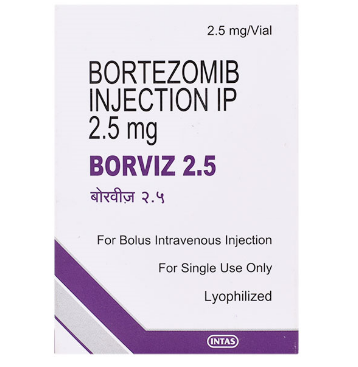Product Introduction:
Borviz contains Bortezomib, a reversible proteasome inhibitor that targets and blocks the 26S proteasome, an enzyme complex responsible for degrading ubiquitinated proteins. Its inhibition disrupts normal homeostasis within cancer cells, triggering apoptosis. Borviz is administered via intravenous or subcutaneous injection under medical supervision.
Uses:
Borviz is primarily used for the treatment of:
-
Multiple Myeloma (both newly diagnosed and relapsed cases)
-
Mantle Cell Lymphoma (MCL)
-
Waldenström’s Macroglobulinemia (off-label use)
-
Light Chain Amyloidosis (off-label)
-
Diffuse Large B-cell Lymphoma (DLBCL) (investigational/combination therapy)
-
Combination regimens with immunomodulators or alkylating agents
Storage Instructions:
-
Store at 2°C–8°C (refrigerator)
-
Keep vial in outer carton to protect from light
-
Once reconstituted, use immediately or within 8 hours if stored at 25°C
-
Do not freeze the reconstituted solution
How It Works (Mechanism of Action):
Bortezomib inhibits the 26S proteasome, a protein complex that degrades misfolded or damaged proteins tagged by ubiquitin. Inhibition of this proteasome leads to accumulation of proteins in cancer cells, causing cellular stress and triggering apoptosis. This mechanism is especially effective in plasma cells like those in multiple myeloma.
Side Effects:
Common side effects:
-
Fatigue
-
Nausea and vomiting
-
Diarrhea or constipation
-
Peripheral neuropathy
-
Thrombocytopenia
-
Fever
Serious side effects:
-
Severe neuropathy (motor and sensory)
-
Neutropenia and anemia
-
Tumor lysis syndrome
-
Hypotension or hypertension
-
Hepatic failure (rare)
-
Pulmonary toxicity
Dosage (Typical Recommended Dose):
-
Standard dose: 1.3 mg/m² body surface area, administered twice weekly for 2 weeks (days 1, 4, 8, 11) followed by a 10-day rest period
-
Cycles typically last 21 days, repeated up to 8 cycles or as recommended
-
Dosage may be adjusted in patients with hepatic or renal impairment
Method of Administration:
-
Administered either by intravenous bolus injection or subcutaneous injection
-
Reconstitute lyophilized powder with normal saline (0.9%)
-
Rotate SC injection sites to minimize skin reactions
-
Administer under supervision of an oncology specialist
Precautions:
-
Monitor for signs of peripheral neuropathy, adjust dose as needed
-
Avoid in patients with moderate to severe hepatic impairment without dose adjustment
-
Use caution in patients with cardiac conditions or hypotension
-
Monitor complete blood counts regularly
-
Avoid alcohol or other neurotoxic drugs during therapy
Drug Interactions:
-
May interact with strong CYP3A4 inhibitors or inducers (e.g., ketoconazole, rifampicin)
-
Potentiates side effects with other myelosuppressive agents
-
Concurrent use with NSAIDs or anticoagulants increases bleeding risk
Allergies:
-
Contraindicated in patients with hypersensitivity to Bortezomib, boron, or mannitol
-
May cause anaphylactic reactions – premedication with antihistamines may be necessary
-
Monitor for injection-site reactions
Overdose Information:
-
Overdose can result in severe hypotension, thrombocytopenia, or pancytopenia
-
No specific antidote; provide supportive care and monitor organ function
-
Hospitalization may be required for management
Missed Dose Instructions:
-
If a dose is missed, consult the treating oncologist to determine the best time to reschedule
-
Do not double up on missed doses
-
Maintain regular treatment schedule for best efficacy
Additional Notes:
-
Patients should avoid live vaccines during therapy
-
Baseline and periodic neurological evaluations recommended
-
Adequate hydration is essential during treatment
-
Educate patients to report unusual bruising, bleeding, or neuropathic symptoms
-
Consider prophylactic antiviral therapy to prevent herpes zoster reactivation



